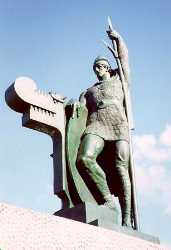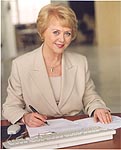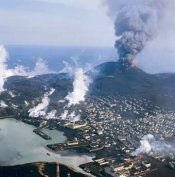About Iceland
Icelandic Geology
The History of Iceland
Höfn í Hornafirði
Culture and Music
There are many things in the Icelandic history, but in this project we tried to take the most important, the things that are noticeable in our history and things that are interesting and even fun to read about. It was a rather difficult project because there is so much we could tell about but we hope that the following text is allright and that you will enjoy reading it.
Our island had several names before it's current name. The first known name of our island was Thule. In the 7th century there was a holy priest called Beda who made a book, "Aldarfarsbók", and there he said that the island was six days away from Britain, going north and traveling by sea. He also said that day wouldn't come in the winter and night wouldn't come in the summer. That description matched Iceland. He named that land Thule.
Later there were a few men who went from Norway and were planning to go to the Faeroe Islands. But they came to our island instead by accident, and when they were leaving it, a lot of snow fell in the mountains so they called the island "Snæland" (Snowland).
A man called Garðar Svavarsson, a Swede, went to look for Snæland after his mother wanted him to. He found the land and after leaving it he went to Norway, there he said great things about Snæland. After that it was called Garðarshólmur (Garðars-holm).
 Then there was a great Viking, Flóki Vilgerðarson was his name. He went to look for Garðarshólmur. He took three ravens with him, because of those ravens he was called Hrafna-Flóki (Raven-Flóki). He let the first one go, but it went straight back to where it came from. The second one flew up and right back down again, but the third one flew forward. Flóki followed it and then they found Garðarshólmur. On Garðarshólmur Flóki climbed a very high mountain and saw a bay full of pack ice, then he named the island Ísland (Iceland), and that name stuck to it.
Then there was a great Viking, Flóki Vilgerðarson was his name. He went to look for Garðarshólmur. He took three ravens with him, because of those ravens he was called Hrafna-Flóki (Raven-Flóki). He let the first one go, but it went straight back to where it came from. The second one flew up and right back down again, but the third one flew forward. Flóki followed it and then they found Garðarshólmur. On Garðarshólmur Flóki climbed a very high mountain and saw a bay full of pack ice, then he named the island Ísland (Iceland), and that name stuck to it.
None of those men who had been to Iceland settled down there. Iceland wasn't settled until the 8th century by the Norwegian Ingólfur Arnarson. He had heard of the land from Hrafna-Flóki and decided to move to it. When Ingólfur saw the land he released two high seat pillars into the sea and said that he would settle down where the pillars came ashore. Ingólfur landed at Ingólfshöfði in Austur-Skaftafellssýsla, which is the same county we're in. He sent two of his slaves to find the two high seat pillars. They found them in a land with a lot of geysers and hot springs with smoke rising from them. He named the land Reykjavík (Smokie bay), and that is where he decided to live. Reykjavík received the right to do commerce in 1786 and today it is our biggest city and our capital.
Our parliament was founded in a place which now is a national park, called Þingvellir in 930. That event is the beginning of our nation state. The parliament is our oldest and most distinguished foundation.
Two men called Gissur hvíti Teitsson and Hjalti Skeggjason brought Christianity to Iceland in the year 1000. Before Christianity belief in the old Nordic gods was our religion. It isn't extinct here now, it is still the religion of a small group of people. The first bishop here in Iceland was Ísleifur Gissurarson, he was the son of Gissur hvíti Teitsson. Iceland was independent for many years but then our parliament decided that we should become subjects of the King of Norway in 1262. Then after Norway went under Denmark, we also did and we didn't get our independencce back until 1944.
A man called Jón Sigurðsson, was a great man in our history. He fought for our independence and we finally got it on the 17th of June 1944, which was also Jón Sigurðsson's birthday.  Now it is our national holiday, which is celebrated each year all over the country. Women were allowed to vote 29 years before we got our independence, it was 1915, in the same year we got our national flag. The white color stands for ice, the red one for fire and the blue one for the blue color in the mountains.
Now it is our national holiday, which is celebrated each year all over the country. Women were allowed to vote 29 years before we got our independence, it was 1915, in the same year we got our national flag. The white color stands for ice, the red one for fire and the blue one for the blue color in the mountains.
Iceland has only had 5 presidents, which maybe isn't such a low number considering that it hasn't been a long time since we got our independence. Our first president was Sveinn Björnsson, Ásgeir Ásgeirsson and Kristján Eldjárn came after him and then there was Vigdís Finnbogadóttir. President Vigdís was the first woman in the history of the world to be elected president of her country. After Vigdís, Ólafur Ragnar Grímsson was elected to be our president and he is our current president.
You can listen to our National Anthem at http://www.musik.is/Lof/E/lofe.html.
On 16th of July 1627, 300 Algerian pirates attacked Vestmannaeyjar. The pirates spent three nights there. They captured people, tied them on their hands and feet, killed the ones who fought back and went after the people who had fled to the mountains. They captured 234 people and brought them to Algeria, they killed 36 people but 200 people were able to hide. This was a very tragic event in the history Vestmannaeyjar and of course also for all Iceland. Later other pirates attacked other places in Iceland.
In 1940 Britain occupied Iceland. Iceland gained a lot from Britain when they were here, because they focused on bringing the transportation to and from Iceland much better. They, for example built the airport in Reykjavík.
In 1941 USA took over from the British army, all the British soldiers went away and American soldiers replaced them. Many people were of the opinion that the armies in Iceland were a bad thing, but they brought a lot to Iceland. Because we were neutral in the war, the armies were just protecting us, and they didn't want Germany to get us first. Anyway, the armies erased all unemployment in Iceland and price on the products we exported out of the country grew higher and the country got more money.
A few other things that took place in history: In the years 1707-1709 was a bad epidemic in Iceland and 25% of the inhabitants died. From 1752-1759 times were hard and there was a big famine. We got our first hospital in 1866. The first trawler came to Iceland in 1905. Iceland became a member of the United Nations in 1946 and a member of NATO in 1949.
Until the turn of the 20th century people lived in houses made of turf, rocks and wood. Those houses were called „torfbær” in Icelandic.

There have been many volcanic eruptions here, there was one in 1104 in a volcano called Hekla, it destroyed all inhabited area in a big region. In 1875 there was another big eruption in a mountain area north of Vatnajökull called Askja. It had bad consequences for the east side of Iceland and many people had to flee and some of them moved all the way to Canada because of the hardship living at this time.
In January 23rd 1973 there was an eruption in Vestmannaeyjar which are islands 15 kilometers off the South coast of Iceland. The eruption happened very suddenly and the town council immediately decided to move all residents away from Vestmannaeyjar. The evacuation went well. The eruption didn't stop until after 5 months and 10 days. Then it had ruined 360 houses, damaged 400 houses and there were minor damages on another 400 houses. Only 3500 people returned to Vestmannaeyjar, 1800 stayed on the continent.
A lot of people in Iceland believe in fairies, trolls, elves and hidden people. They believe that they are living in the nature, mostly in rocks. There really hasn't been any proof that they do exist nor that they don't exist. We have a lot of folk tales which tell us about those „hidden” worlds.
Written by Emil und Valdís